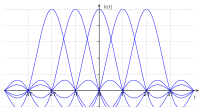
Photo from wikipedia
In an orthogonal frequency division multiplexing (OFDM) system, the cyclic prefix (CP) has traditionally been not useful for data detection at the receiver. This paper presents a low-complexity turbo-OFDM receiver… Click to show full abstract
In an orthogonal frequency division multiplexing (OFDM) system, the cyclic prefix (CP) has traditionally been not useful for data detection at the receiver. This paper presents a low-complexity turbo-OFDM receiver to exploit all of the extra information offered by the CP to improve the data detection and channel estimation performance. In the receiver, two iterative processes, namely, the outer iteration based on the turbo equalization principle and the inner iteration based on the expectation–maximization algorithm, are proposed. The CP observation, which contains extra information about data and channel, is represented by a Forney-style factor graph and incorporated into the inner iteration for joint channel estimation and data detection, using a Gaussian message passing process. The extrinsic messages of the data enhanced by exploiting the CP are then exchanged in the outer iteration for joint channel estimation, data detection, and decoding to further improve a system performance. To effectively implement the receiver, several approximations are introduced to reduce the computational complexity to be logarithmic in the length of the OFDM symbol $N$ , i.e., $\mathcal O(NlogN)$ per OFDM symbol. Extensive simulation results show that the bit error rate performance of the proposed low-complexity turbo-OFDM receiver is superior to that of existing turbo-OFDM receivers with exploiting the channel information in the CP only or without exploiting the CP, as well as conventional OFDM receivers, in particular for time-varying channels.
Journal Title: IEEE Access
Year Published: 2017
Link to full text (if available)
Share on Social Media: Sign Up to like & get
recommendations!